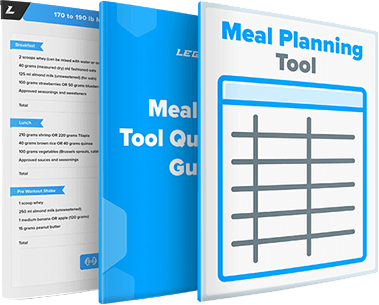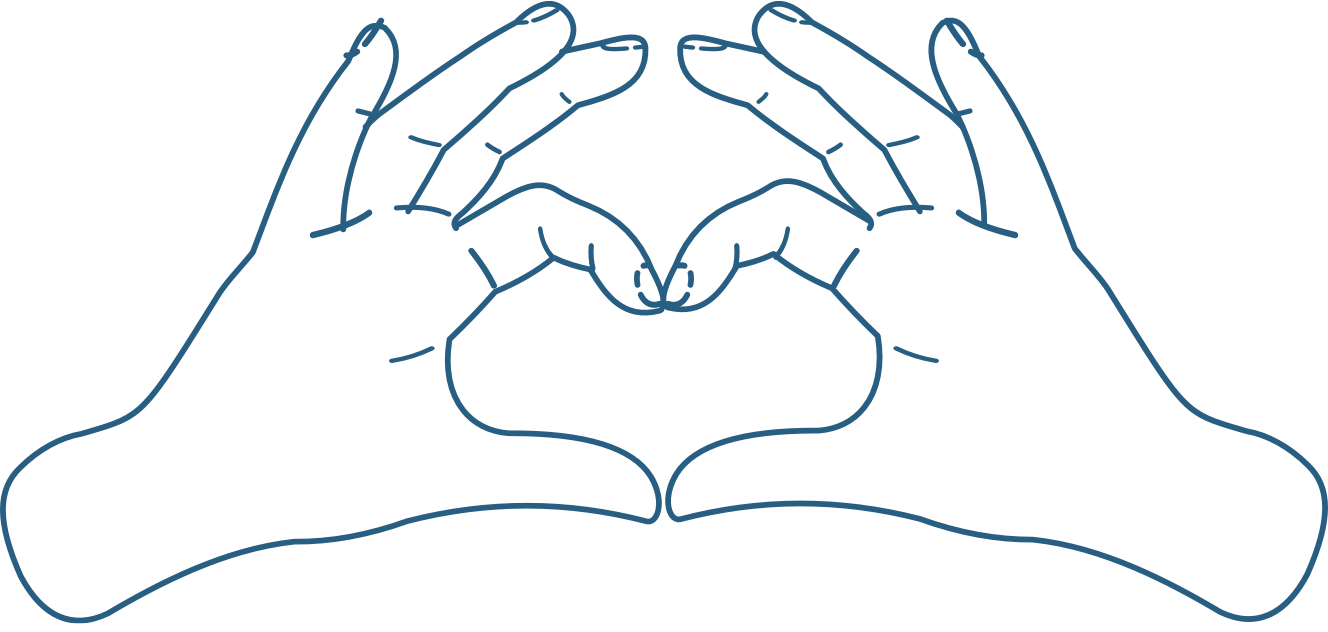A bro split—also known as a body-part split—is a workout routine that trains your chest, back, shoulders, legs, and arms on different days of the week.
You’ve probably heard the evidence-based fitness crowd dismiss it as inefficient, unscientific, and a waste of time. Their main criticism is that it doesn’t train your muscles often enough to maximize growth.
Yet, bro split workout plans remain extremely popular among gymgoers, especially those new to training.
But if training different muscle groups on different days is a fool’s errand, why do so many people swear by it?
Because the bro split is simple, enjoyable, and—when done correctly—highly effective for building muscle and strength.
The key, of course, is getting the programming right. Get it wrong, and you’ll likely spend months spinning your wheels with little to show for your effort.
In this article, you’ll learn everything you need to know to make a bro split work for you. You’ll also discover how to maximize the bro split’s effectiveness and how it stacks up against other popular routines like push pull legs, full-body, and the upper lower split.
Want to know exactly how you should train to reach your fitness goals? Take our free 60-second training quiz and find out now.
Key Takeaways
- A bro split workout plan trains different muscle groups on separate days, which is a structure many people find simple and enjoyable.
- Some evidence-based fitness experts criticize bro splits for not training muscles frequently enough to maximize growth. But, when programmed correctly, a bro split workout routine can be highly effective for building muscle and strength.
- It works especially well for beginners because they don’t need to train each muscle group as frequently as more experienced trainees to make progress.
- The key to a successful bro split workout plan is focusing on compound exercises, doing the right number of sets in each workout, and applying progressive overload.
- To accelerate your progress on a bro split, use a high-quality protein powder to hit your daily protein target, creatine to boost recovery and growth, and a pre-workout to enhance energy, focus, and performance.
- Whether a bro split workout plan is better or worse than routines like push pull legs or upper lower depends on your goals, preferences, and circumstances.
Table of Contents
+
What Is a Bro Split?
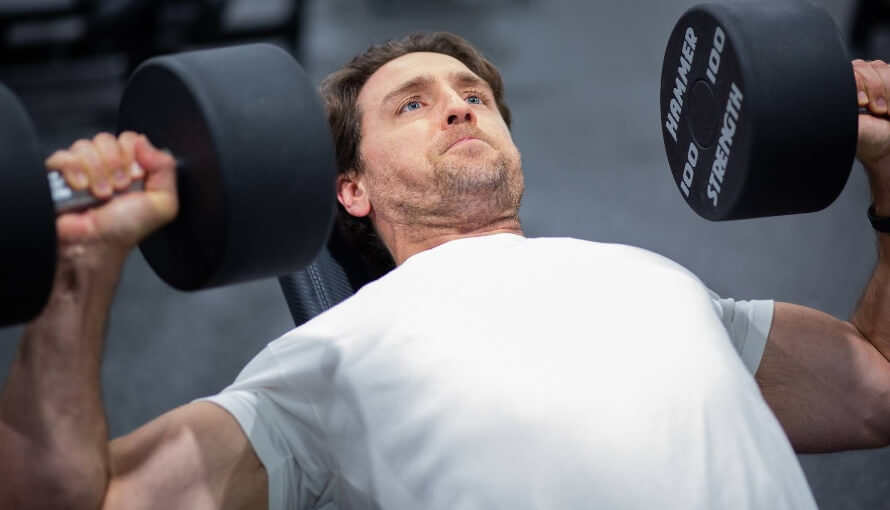
A bro split—also known as a body-part split—is a workout routine that trains each major muscle group (or body part) on different days of the week.
You typically train each muscle group once per week, so a 5-day bro split workout plan normally looks something like this:
- Monday: Chest
- Tuesday: Back
- Wednesday: Shoulders
- Thursday: Arms
- Friday: Legs
- Saturday: Rest
- Sunday: Rest
Generally speaking, bro splits involve doing a lot of sets and reps in each workout, leaving the target muscle group sore and pumped.
In fact, this is one of the reasons bro splits are popular. Many people are under the (false) impression that the more you train a muscle group in a single workout, the more it grows afterward.
As you’ll learn in a moment, however, hammering a single muscle group with six or ten or more exercises in a row isn’t a smart way to program a bro split workout plan.
Is the Bro Split Effective for Building Muscle?
Yes—the bro split is effective for building muscle if you program it correctly. And it’s especially effective for beginners in their first year or so of weightlifting.
To understand why bro splits work—and how to make them work for you—you need to know what they do well and how to avoid the common mistakes that limit their results.
The best way to do that is to weigh the pros and cons.
Bro Split Routine Benefits
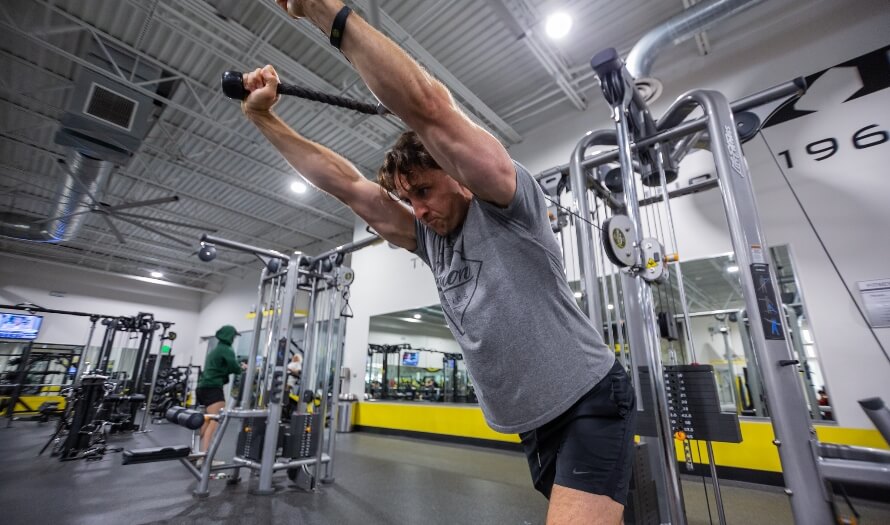
Simple Programming
The biggest benefit of the bro split routine is that it’s simple.
Each workout has a specific goal (to train your chest, for example), so you know exactly what you’re doing every time you set foot in the gym.
Enjoyable Workouts
Many people also enjoy bro splits, and we tend to push ourselves harder when we enjoy our training.
Dedicating an entire session to a single muscle group means you can train it with enough volume (sets and reps) in each workout to get a big pump, which isn’t necessary for muscle growth, but which has also been famously likened to having an orgasm.
Upper Body Emphasis
Another reason many guys like bro split workout routines is they typically emphasize upper-body training. If you follow a 5-day bro split routine like the example I shared earlier, for instance, then you’re spending four out of five days in the gym training your upper body muscles.
This cuts both ways, though, because bro splits are often lousy for people who want to emphasize their lower bodies, which includes many women. That said, you can set up a bro split in a way that includes more lower-body training.
Bro Split Routine Drawbacks

Low Training Frequency
The biggest knock on bro splits is that they don’t train each muscle group often enough.
Research shows you’ll build muscle faster by training each major muscle group at least twice per week, especially if you’ve been lifting for more than a year. Bro splits typically hit each one just once weekly.
Some people try to compensate by cramming more sets into each workout, but this usually backfires because:
- You’re forced to lift lighter weights as your workout drags on and you fatigue.
- You cause soreness that impacts future workouts. For example, “blasting” your chest on Monday can wreck your shoulder workout on Wednesday.
These issues may not be obvious at first, but they slow progress over time.
Missed Growth Opportunities
Bro split routines also leave gains on the table due to how muscle protein synthesis (MPS) works.
Research shows that MPS spikes after a workout and drops back to baseline within 10–48 hours (the more experienced you are, the faster MPS declines after a workout).
If you wait a full week before training that muscle again, that’s several days where you’re not building muscle.
What’s more, this effect becomes more important the more advanced you are, because experienced gymgoers recover faster and need to train their muscles more frequently to keep growing.
That said, with a few simple tweaks, you can avoid these common issues and make the bro splits an effective training plan.
How to Fix Common Bro Split Mistakes
The key to making a bro split work is choosing the right exercises, doing the right amount of volume, and focusing on what makes muscles grow. Here’s what you need to know.
Exercise Selection
To make the bro split work, do mainly compound exercises that train multiple muscle groups at once.
That way, even if you only train a muscle directly once per week, you’re still indirectly training it 1–2 times weekly thanks to overlap between exercises, which is enough for most people to grow.
For example:
- Bench pressing trains your chest, shoulders, and triceps
- Rows train your back, biceps, and shoulders
- Squats and deadlifts train both your legs and back
Manage Volume
Another fix is managing your volume. Bad bro splits tend to include a lot of “junk volume”—extra sets and reps that don’t produce meaningful gains and just make recovery harder.
Studies show that a muscle’s performance drops after around 6–10 sets in a single workout. When that happens, you lift less weight, for fewer reps, with worse form—all of which can hinder growth.
A good rule of thumb is to aim for no more than 10 sets per major muscle group per workout.
Emphasize Progressive Overload
Many bro splits are designed to make your muscles feel sore and pumped after training. While this may feel satisfying, it doesn’t do much for growth.
A more effective strategy is to focus on getting stronger over time. This is called progressive overload, and it’s the biggest driver of hypertrophy. Here’s how to apply it:
If your workout calls for 4–6 reps of the bench press and you complete 6 reps in a set, increase the weight by 10 pounds for your next set.
If you do 3 reps or fewer in subsequent sets, reduce the load by 5 pounds to stay in the 4–6 rep range.
Apply this approach to every exercise in your bro split workouts, aiming to add either weight or reps every session.
The Best Bro Split Workout Plan for Building Muscle
When it comes to how well a bro split will work for you, the devil is in the details.
So long as the bro split routine you follow is based around compound exercises, you’re pushing for progressive overload in every workout, and, if you’ve been training for a year or longer, you train each muscle group at least twice per week, you can make excellent progress.
Here’s a bro split workout plan that checks all of these boxes:
Day 1: Chest
- Flat Barbell Bench Press: 3 sets | 4–6 reps | 3–5 min rest
- Incline Barbell Bench Press: 3 sets | 4–6 reps | 3–5 min rest
- Dip: 3 sets | 8–10 reps | 2–3 min rest
- Triceps Pushdown: 3 sets | 8–10 reps | 2–3 min rest
Day 2: Back
- Barbell Deadlift: 3 sets | 4–6 reps | 3–5 min rest
- One-arm Dumbbell Row: 3 sets | 4–6 reps | 3–5 min rest
- Chin-up: 3 sets | 8–10 reps | 2–3 min rest
- Lat Pulldown: 3 sets | 8–10 reps | 2–3 min rest
Day 3: Shoulders
- Barbell Overhead Press: 3 sets | 4–6 reps | 3–5 min rest
- Arnold Press: 3 sets | 8–10 reps | 2–3 min rest
- Dumbbell Side Lateral Raise: 3 sets | 8–10 reps | 2–3 min rest
- Dumbbell Rear Lateral Raise: 3 sets | 8–10 reps | 2–3 min rest
Day 4: Legs
- Barbell Back Squat: 3 sets | 4–6 reps | 3–5 min rest
- Romanian Deadlift: 3 sets | 4–6 reps | 3–5 min rest
- Leg Press: 3 sets | 8–10 reps | 2–3 min rest
- Seated Calf Raise: 3 sets | 8–10 reps | 2–3 min rest
Day 5: Arms
- Close-grip Bench Press: 3 sets | 4–6 reps | 3–5 min rest
- Barbell Curl: 3 sets | 8–10 reps | 2–3 min rest
- Overhead Triceps Extension: 3 sets | 8–10 reps | 2–3 min rest
- Incline Dumbbell Curl: 3 sets | 8–10 reps | 2–3 min rest
The Best Supplements for the Bro Split Workout Plan
If you’re training hard on a bro split, your results will ultimately come down to how well you manage your recovery, diet, and consistency.
That said, the right supplements can make a noticeable difference in how you perform and recover between sessions. Here are three that pair especially well with a bro split:
- Protein powder: Protein powder, such as whey or casein, provides your body with the nutrients needed to build muscle tissue and recover from workouts. For a clean and delicious protein powder, try Whey+ or Casein+.
- Creatine: Creatine boosts muscle and strength gain, improves anaerobic endurance, and reduces muscle damage and soreness from your workouts. For a natural source of creatine, try our creatine monohydrate, creatine gummies, or Recharge.
- Pre-workout: A high-quality pre-workout enhances energy, mood, and focus, increases strength and endurance, and reduces fatigue. For a top-tier pre-workout containing clinically effective doses of 6 science-backed ingredients, try Pulse with caffeine or without.
(If you’d like even more specific advice about which supplements you should take to reach your health and fitness goals, take the Legion Supplement Finder Quiz, and in less than a minute, you’ll know exactly what supplements are right for you.)
The Bro Split vs. Other Workout Routines
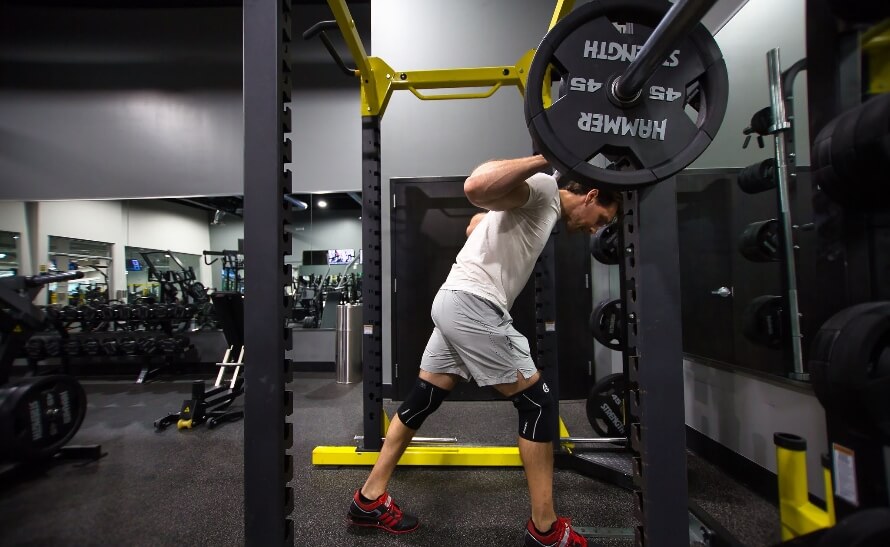
When it comes to workout splits, the bro split faces stiff competition. How does it stack up against other popular routines like push pull legs, the upper lower split, and full-body training? And which is the best fit for your goals?
Let’s break it down.
Bro Split vs. PPL Split
The idea of PPL is simple:
- On push days you train your pecs, delts, and triceps.
- On pull days you train your back and biceps.
- On leg days you train your glutes, hamstrings, quads, and calves.
In most cases, a standard PPL split looks like this:
- Monday: Push
- Tuesday: Rest
- Wednesday: Pull
- Thursday: Rest
- Friday: Legs
- Saturday: Rest
- Sunday: Rest
The pros of this workout split are that it’s simple, time-tested, and time efficient.
The main cons of PPL, though, are that you only train each muscle group once per week, and because you only train three times per week in total, it’s difficult to do enough volume in each workout to maximize muscle growth.
If you’re pressed for time and can only make it to the gym three days a week, the PPL split will probably fit your schedule better than a traditional bro split. However, if you have a little more time to dedicate to training, you’ll probably gain more muscle and strength following a well-designed bro-split workout plan.
READ MORE: The Best Push Pull Legs Routines for Mass Gains
Bro Split vs. Full Body Split
Full-body workouts are workouts in which you train several major muscle groups across your entire body in each session. Most full-body workout splits have you training anywhere from 3–5 days per week, depending on your experience, goals, and schedule, and normally look something like this:
- Monday: Full Body
- Tuesday: Rest or Full Body
- Wednesday: Full Body
- Thursday: Rest or Full Body
- Friday: Full Body
- Saturday: Rest
- Sunday: Rest
The biggest advantage of full-body routines is frequency—they train every major muscle group at least twice per week, which is the sweet spot for building muscle.
The main downside is that it can be easy to mess up. Because of the high frequency, you have to carefully manage your volume. Otherwise, you risk doing too much, which can lead to burnout.
What’s more, research shows training a muscle group once per week isn’t much better than training it more when you’re new to weightlifting. Thus, a bro split routine would likely be just as good for beginners as a full-body split.
As you get more advanced, though, higher frequency becomes more important. After your first year or so of lifting, you’ll likely build muscle faster by training each muscle group at least twice per week (though it’s still unclear whether going beyond that offers additional benefits).
READ MORE: The Best Full-Body Workout Routines for Building Muscle
Bro Split vs. Upper Lower Split
An upper lower workout split organizes training into upper-body and lower-body workouts.
Here’s how most people set it up:
- Monday: Upper
- Tuesday: Lower
- Wednesday: Rest
- Thursday: Upper
- Friday: Lower
- Saturday: Rest
- Sunday: Rest
The biggest advantage of the upper lower split is that it balances volume and frequency well. You train each major muscle group at least twice per week, while still getting plenty of recovery.
The biggest downside, however, is that workouts tend to be long. For example, on a typical upper-body day you train your chest, shoulders, arms, and back in one go. It’s a push pull workout for your upper-body, basically.
That works fine for a while, but the gears begin to grind once you’re doing more than 15 sets per muscle group per week. At that point, you may need to spread the volume across more days.
Most upper lower splits also train your lower and upper body equally, which may or may not be optimal for your circumstances. For instance, if you have small legs but a well-developed upper body, you’ll probably want a plan that gives more attention to your lower half.
READ MORE: The Best 3-, 4- & 5-Day Upper Lower Workout Splits for Mass
FAQ #1: Is the bro split good for beginners?
Yes, a bro split workout plan can be good for beginners. New weightlifters respond well to bro splits because they don’t need to train each muscle group as frequently as more experienced trainees to see progress. Training a muscle once per week is usually enough.
That said, the success of a bro split for beginners depends on programming. If the workout plan contains plenty of compound exercises, includes enough volume, and prioritizes progressive overload, a bro split can deliver excellent results.
If it doesn’t meet this criteria, however, it won’t be nearly as effective.
FAQ #2: Can you do a 4-day bro split workout plan?
Yes, you can do a 4-day bro split. There are a few ways to program this type of workout plan, but the most common is to drop a specific arm day, and tag biceps and triceps training onto the end of chest and back days.
Here’s how a 4-day bro split following these guidelines might look:
Day 1: Chest and Triceps
Flat Barbell Bench Press: 3 sets | 4–6 reps | 3–5 min rest
Incline Barbell Bench Press: 3 sets | 4–6 reps | 3–5 min rest
Dip: 3 sets | 8–10 reps | 2–3 min rest
Overhead Triceps Extension: 3 sets | 8–10 reps | 2–3 min rest
Day 2: Back and Biceps
Barbell Deadlift: 3 sets | 4–6 reps | 3–5 min rest
One-arm Dumbbell Row: 3 sets | 4–6 reps | 3–5 min rest
Pull-up: 3 sets | 8–10 reps | 2–3 min rest
Barbell Curl: 3 sets | 8–10 reps | 2–3 min rest
Day 3: Shoulders
Barbell Overhead Press: 3 sets | 4–6 reps | 3–5 min rest
Arnold Press: 3 sets | 8–10 reps | 2–3 min rest
Dumbbell Side Lateral Raise: 3 sets | 8–10 reps | 2–3 min rest
Dumbbell Rear Lateral Raise: 3 sets | 8–10 reps | 2–3 min rest
Day 4: Legs
Barbell Back Squat: 3 sets | 4–6 reps | 3–5 min rest
Romanian Deadlift: 3 sets | 4–6 reps | 3–5 min rest
Leg Press: 3 sets | 8–10 reps | 2–3 min rest
Seated Calf Raise: 3 sets | 8–10 reps | 2–3 min rest
FAQ #3: Can you do a 6-day bro split workout plan?
Yes, you can do a 6-day bro split, but they’re not as common as 5- and 4-day routines. In most cases, a 6 day bro split is the same as a 5-day split with an extra workout dedicated to a specific muscle group that needs more attention.
For example, if your chest is lagging, you might add a second chest day. Or, if your upper chest is underdeveloped compared to your mid and lower chest, you might do separate lower and upper pec workouts weekly.
Many people also use the extra day in a 6-day bro split to do some direct ab training. This ensures their abs get the attention they need to grow optimally without cutting into other workouts during the week.
Scientific References +
- GT, M., JR, H., AM, G., JR, T., AJ, W., AR, J., KS, B., CH, B., AA, M., R, W., MB, L., DH, F., NA, R., & JR, S. (2015). The effect of training volume and intensity on improvements in muscular strength and size in resistance-trained men. Physiological Reports, 3(8). https://doi.org/10.14814/PHY2.12472
- BJ, S., D, O., & JW, K. (2016). Effects of Resistance Training Frequency on Measures of Muscle Hypertrophy: A Systematic Review and Meta-Analysis. Sports Medicine (Auckland, N.Z.), 46(11), 1689–1697. https://doi.org/10.1007/S40279-016-0543-8
- E R Helms, P J Fitschen, A A Aragon, J Cronin, & B J Schoenfeld. (n.d.). Recommendations for natural bodybuilding contest preparation: resistance and cardiovascular training - PubMed. Retrieved July 25, 2021, from https://pubmed.ncbi.nlm.nih.gov/24998610/
- F, D., S, P., FC, V., & C, U. (2015). A review of resistance training-induced changes in skeletal muscle protein synthesis and their contribution to hypertrophy. Sports Medicine (Auckland, N.Z.), 45(6), 801–807. https://doi.org/10.1007/S40279-015-0320-0
- Stokes, Tanner, et al. “Recent Perspectives Regarding the Role of Dietary Protein for the Promotion of Muscle Hypertrophy with Resistance Exercise Training.” Nutrients, vol. 10, no. 2, 7 Feb. 2018, p. 180, www.mdpi.com/2072-6643/10/2/180/pdf.
- Eckerson, Joan M., et al. “Effect of Creatine Phosphate Supplementation on Anaerobic Working Capacity and Body Weight after Two and Six Days of Loading in Men and Women.” The Journal of Strength and Conditioning Research, vol. 19, no. 4, 2005, p. 756, https://doi.org/10.1519/r-16924.1.
- Bassit, Reinaldo Abunasser, et al. “Effect of Short-Term Creatine Supplementation on Markers of Skeletal Muscle Damage after Strenuous Contractile Activity.” European Journal of Applied Physiology, vol. 108, no. 5, 3 Dec. 2009, pp. 945–955, https://doi.org/10.1007/s00421-009-1305-1.
- Wernbom, Mathias, et al. “The Influence of Frequency, Intensity, Volume and Mode of Strength Training on Whole Muscle Cross-Sectional Area in Humans.” Sports Medicine, vol. 37, no. 3, 2007, pp. 225–264, https://doi.org/10.2165/00007256-200737030-00004.
